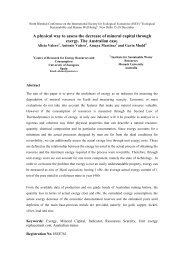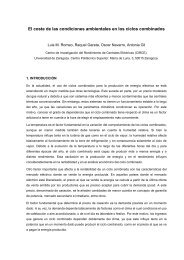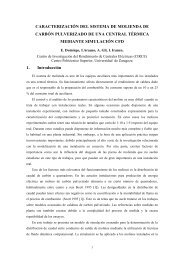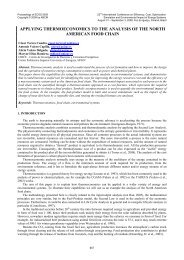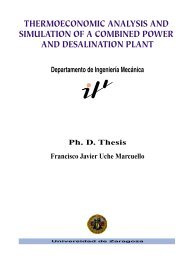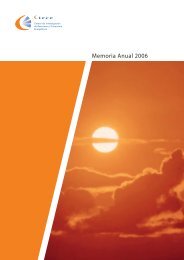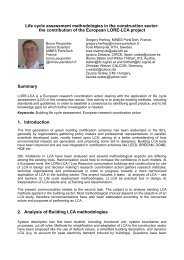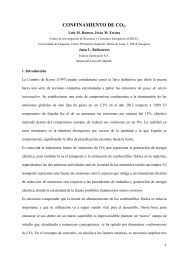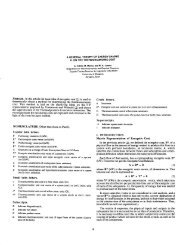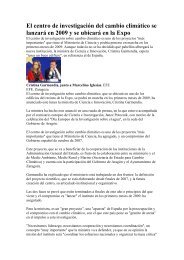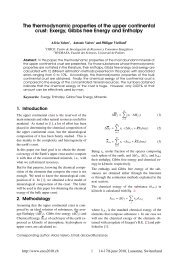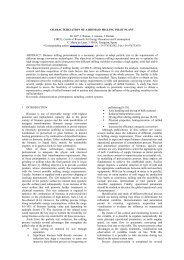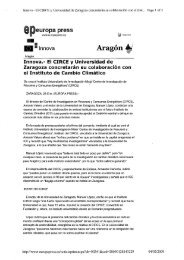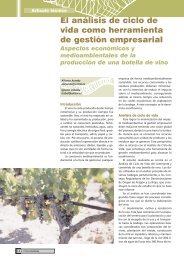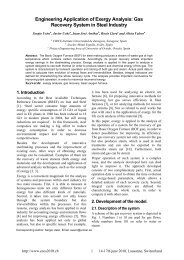Exergy evolution of the mineral capital on earth - circe
Exergy evolution of the mineral capital on earth - circe
Exergy evolution of the mineral capital on earth - circe
You also want an ePaper? Increase the reach of your titles
YUMPU automatically turns print PDFs into web optimized ePapers that Google loves.
The reference envir<strong>on</strong>ment 153<br />
5.2.3.5 The updated reference envir<strong>on</strong>ment. Results<br />
Table 5.4 shows <str<strong>on</strong>g>the</str<strong>on</strong>g> results obtained in this study for <str<strong>on</strong>g>the</str<strong>on</strong>g> chemical exergy <str<strong>on</strong>g>of</str<strong>on</strong>g> <str<strong>on</strong>g>the</str<strong>on</strong>g><br />
elements with <str<strong>on</strong>g>the</str<strong>on</strong>g> geochemical informati<strong>on</strong> <str<strong>on</strong>g>of</str<strong>on</strong>g> <str<strong>on</strong>g>the</str<strong>on</strong>g> crust (MW cr and z 0i) obtained<br />
in this PhD (This study 1) and <str<strong>on</strong>g>the</str<strong>on</strong>g> <strong>on</strong>e provided by Grigor’ev [127] (This study 2).<br />
The solid R.S. assumed are those taken by Szargut [336], basing <strong>on</strong> <str<strong>on</strong>g>the</str<strong>on</strong>g> Szargut’s<br />
criteri<strong>on</strong> menti<strong>on</strong>ed before. Additi<strong>on</strong>ally, <str<strong>on</strong>g>the</str<strong>on</strong>g> values are compared to those given by<br />
Szargut [336], Valero, Ranz and Botero [371] and Rivero and Garfias [281]. The<br />
different reference substances divided into liquid, gaseous and solid R.S. and <str<strong>on</strong>g>the</str<strong>on</strong>g><br />
values required for <str<strong>on</strong>g>the</str<strong>on</strong>g> calculati<strong>on</strong>s are shown in tables A.13, A.14 and A.15 in <str<strong>on</strong>g>the</str<strong>on</strong>g><br />
appendix, page 384.<br />
The average difference between our study (1) and Szargut’s values is around 0,66%<br />
<strong>on</strong> average, while between study (2) with Grigor’ev’s model and Szarguts’, about<br />
0,93%. Hence, in both cases, <str<strong>on</strong>g>the</str<strong>on</strong>g> average differences are very small. Never<str<strong>on</strong>g>the</str<strong>on</strong>g>less,<br />
small differences multiplied by huge numbers, such as <str<strong>on</strong>g>the</str<strong>on</strong>g> quantity <str<strong>on</strong>g>of</str<strong>on</strong>g> all <str<strong>on</strong>g>mineral</str<strong>on</strong>g>s<br />
<strong>on</strong> <strong>earth</strong>, make <str<strong>on</strong>g>the</str<strong>on</strong>g>se discrepancies to be not so insignificant. Next, each <str<strong>on</strong>g>of</str<strong>on</strong>g> <str<strong>on</strong>g>the</str<strong>on</strong>g><br />
three subsystems (gaseous, liquid and solid R.S.) is analyzed, stressing <str<strong>on</strong>g>the</str<strong>on</strong>g> biggest<br />
differences found in <str<strong>on</strong>g>the</str<strong>on</strong>g> different models.<br />
The obtained values for gaseous R.S. are <str<strong>on</strong>g>the</str<strong>on</strong>g> same <str<strong>on</strong>g>of</str<strong>on</strong>g> those obtained by Szargut<br />
[336] and Valero, Ranz and Botero [371], since <str<strong>on</strong>g>the</str<strong>on</strong>g> methodology and <str<strong>on</strong>g>the</str<strong>on</strong>g> values<br />
used for this R.E. have been <str<strong>on</strong>g>the</str<strong>on</strong>g> same. The differences between this study (1) and<br />
(2) and that <str<strong>on</strong>g>of</str<strong>on</strong>g> Rivero and Garfias [281] are due to <str<strong>on</strong>g>the</str<strong>on</strong>g> different partial pressures in<br />
<str<strong>on</strong>g>the</str<strong>on</strong>g> atmosphere assumed.<br />
The new chemical exergies obtained differ in 0,5% in average for study (1) and<br />
1% for study (2) with respect to <str<strong>on</strong>g>the</str<strong>on</strong>g> values obtained by Szargut in [336] for solid<br />
reference substances. Taking <str<strong>on</strong>g>the</str<strong>on</strong>g> empirical standard molar c<strong>on</strong>centrati<strong>on</strong> <str<strong>on</strong>g>of</str<strong>on</strong>g> solid<br />
R.S. from our model instead <str<strong>on</strong>g>of</str<strong>on</strong>g> obtaining it with Eq. 5.3, implies a difference in <str<strong>on</strong>g>the</str<strong>on</strong>g><br />
element chemical exergy <str<strong>on</strong>g>of</str<strong>on</strong>g> about 0,2% except for Au (9,5%) and F (6,7%). For<br />
<str<strong>on</strong>g>the</str<strong>on</strong>g> latter elements, <str<strong>on</strong>g>the</str<strong>on</strong>g> greater difference is due to <str<strong>on</strong>g>the</str<strong>on</strong>g> greater sensitivity <str<strong>on</strong>g>of</str<strong>on</strong>g> Au to<br />
x i (since its ∆G f is equal to zero) and <str<strong>on</strong>g>the</str<strong>on</strong>g> great proporti<strong>on</strong> <str<strong>on</strong>g>of</str<strong>on</strong>g> atoms <str<strong>on</strong>g>of</str<strong>on</strong>g> Ca in <str<strong>on</strong>g>the</str<strong>on</strong>g><br />
reference substance <str<strong>on</strong>g>of</str<strong>on</strong>g> F (CaF 2), respectively. It must be stressed that choosing a<br />
certain c j or ano<str<strong>on</strong>g>the</str<strong>on</strong>g>r a 100 times greater, throws less differences in <str<strong>on</strong>g>the</str<strong>on</strong>g> chemical<br />
exergy <str<strong>on</strong>g>of</str<strong>on</strong>g> <str<strong>on</strong>g>the</str<strong>on</strong>g> elements than choosing ano<str<strong>on</strong>g>the</str<strong>on</strong>g>r R.S., as can be seen in <str<strong>on</strong>g>the</str<strong>on</strong>g> models <str<strong>on</strong>g>of</str<strong>on</strong>g><br />
Valero et al. [371] and Rivero et al. [281], when o<str<strong>on</strong>g>the</str<strong>on</strong>g>r R.S. are c<strong>on</strong>sidered. The<br />
same thing happens with <str<strong>on</strong>g>the</str<strong>on</strong>g> molecular weight <str<strong>on</strong>g>of</str<strong>on</strong>g> <str<strong>on</strong>g>the</str<strong>on</strong>g> <strong>earth</strong>’s crust. An MW cr <str<strong>on</strong>g>of</str<strong>on</strong>g><br />
142,1 or 155,2 <strong>on</strong>ly modifies <str<strong>on</strong>g>the</str<strong>on</strong>g> chemical exergy <str<strong>on</strong>g>of</str<strong>on</strong>g> <str<strong>on</strong>g>the</str<strong>on</strong>g> elements in 0,03%, and<br />
hence that parameter is not crucial at all.<br />
For <str<strong>on</strong>g>the</str<strong>on</strong>g> liquid R.S., with <str<strong>on</strong>g>the</str<strong>on</strong>g> excepti<strong>on</strong> <str<strong>on</strong>g>of</str<strong>on</strong>g> SO −2<br />
4 <str<strong>on</strong>g>the</str<strong>on</strong>g> differences are negligible from<br />
<str<strong>on</strong>g>the</str<strong>on</strong>g> point <str<strong>on</strong>g>of</str<strong>on</strong>g> view <str<strong>on</strong>g>of</str<strong>on</strong>g> <str<strong>on</strong>g>the</str<strong>on</strong>g> influence <strong>on</strong> <str<strong>on</strong>g>the</str<strong>on</strong>g> final exergy <str<strong>on</strong>g>of</str<strong>on</strong>g> <str<strong>on</strong>g>the</str<strong>on</strong>g> c<strong>on</strong>sidered element. In<br />
<str<strong>on</strong>g>the</str<strong>on</strong>g> case <str<strong>on</strong>g>of</str<strong>on</strong>g> SO −<br />
4 , Szargut and Valero et al. assumed a value <str<strong>on</strong>g>of</str<strong>on</strong>g> mSO −2 = 1,17E-2, and<br />
4<br />
Rivero m −2<br />
SO = 1,24E-2. The molarity calculated basing <strong>on</strong> <str<strong>on</strong>g>the</str<strong>on</strong>g> three independent<br />
4<br />
sources [225], [264] and [231] is estimated as m −2<br />
SO = 2,93E-2 and is almost 2,5<br />
4



